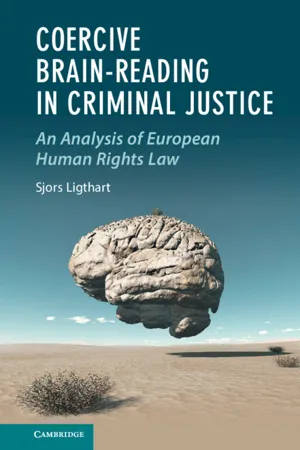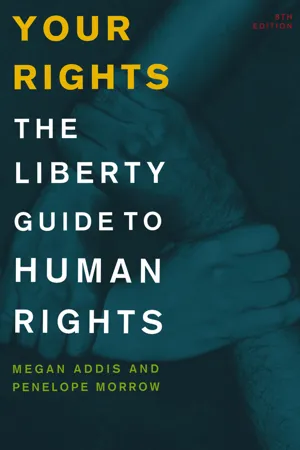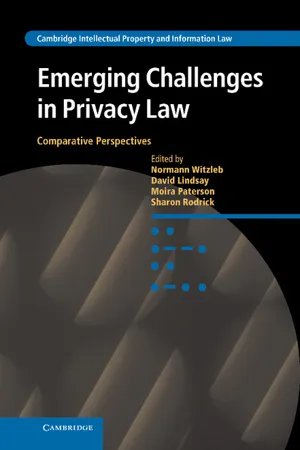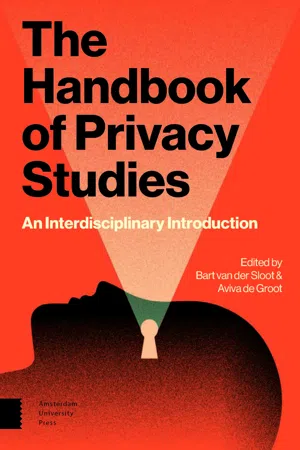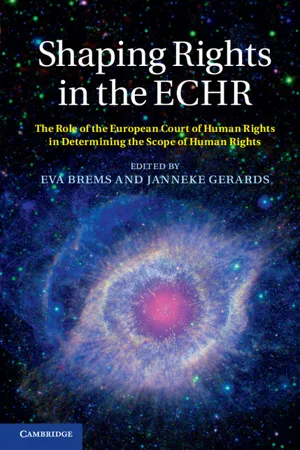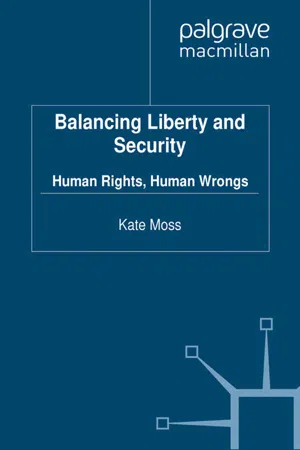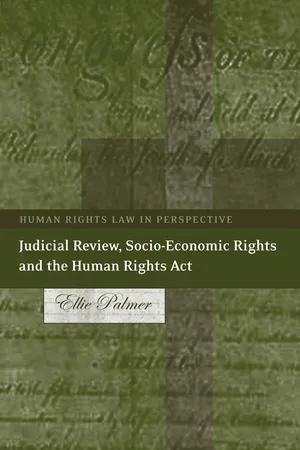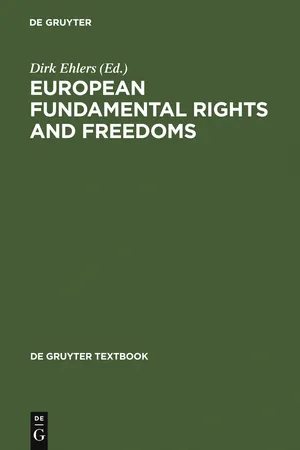Law
Article 8 echr
Article 8 of the European Convention on Human Rights (ECHR) protects the right to respect for private and family life, home, and correspondence. It encompasses a wide range of personal and family relationships, as well as the right to privacy and protection from arbitrary interference by public authorities. This article is a fundamental component of human rights law, ensuring individuals' privacy and family life are safeguarded.
Written by Perlego with AI-assistance
Related key terms
1 of 5
10 Key excerpts on "Article 8 echr"
- eBook - PDF
Coercive Brain-Reading in Criminal Justice
An Analysis of European Human Rights Law
- Sjors Ligthart(Author)
- 2022(Publication Date)
- Cambridge University Press(Publisher)
2020. 69 4.2 The Right to Respect for Private Life (Article 8 echr) society in the interests of national security, public safety or the economic well-being of the country, for the prevention of disorder or crime, for the protection of health or morals, or for the protection of the rights and freedoms of others. In essence, the first paragraph of this provision aims to protect individuals against arbitrary interferences with their private and family life, home, and correspondence. 2 Yet, not any such interference will necessarily violate Article 8 echr. Instead, infringements can be justified via Article 8(2) ECHR when they are in accordance with the law, serve a legitimate aim, and are necessary in a democratic society. In examining complaints about Article 8 echr, the Court normally begins with determining whether this provision is applicable to the individual case and whether the issue at stake constitutes an infringement. Next, it examines whether the infringement is justified or whether it constitutes a violation. 3 Accordingly, in what follows, first, the meaning and scope of the right to respect for private life will be considered, followed by a discussion of the justification clause of Article 8(2) ECHR. 4.2.2 Article 8(1) ECHR: The Right to Respect for Private Life The first paragraph of Article 8 echr prescribes to respect four distinctive privacy interests of each individual: one’s private life, family life, home, and correspondence. In particular, coercive brain-reading raises questions regarding the right to respect for private life. The present chapter focusses on this part of Article 8(1) ECHR. When interpreting the rights guaranteed by Article 8 echr, the notion of per- sonal autonomy is an important principle. - eBook - PDF
Your Rights
The Liberty Guide to Human Rights
- Megan Addis, Penelope Morrow(Authors)
- 2005(Publication Date)
- Pluto Press(Publisher)
James Strachan 3 The Right to Privacy This chapter deals with: • Article 8 – the right to respect for private and family life, home and correspondence • Confidential information • Spent convictions and the rehabilitation of offenders • Telephone tapping and interception of communications • Surveillance and undercover human intelligence sources • Other types of surveillance • Investigation of electronic data protected by encryption • Use of photographs, fingerprints, DNA samples and other samples taken at police stations • Harassment, unwanted letters and telephone calls • Power of officials to enter your home • Searches by Customs and Excise officials • Gender identity and sexuality • Privacy and the media • Further information 3.1 ARTICLE 8 – THE RIGHT TO RESPECT FOR PRIVATE AND FAMILY LIFE, HOME AND CORRESPONDENCE In essence, the incorporation of Article 8 of the European Convention on Human Rights (the Convention) into UK law by the Human Rights Act 1998 (HRA) creates a general right to respect for privacy where none previously existed. Article 8 offers general protection for a person’s private and family life, home and correspondence from arbitrary interference by the State. This right affects a large number of areas of life ranging from surveillance to sexual identity – it is framed extremely broadly. However, the right to respect for these aspects of privacy under Article 8 is qualified. This means that interferences by the State can be permissible, but such interferences must be justified and satisfy certain conditions. Any interference with your right must be: • In accordance with law; and • In the interests of the legitimate objectives identified in Article 8(2); and • Necessary in a democratic society. In accordance with law In many cases decided by the European Court of Human Rights (ECHR), interferences with privacy have been in breach of Article 8 because they have not satisfied this 40 - eBook - ePub
- Howard Davis(Author)
- 2014(Publication Date)
- Routledge(Publisher)
Chapter 8Rights to privacy and propertyLEARNING OBJECTIVES
On completing this chapter the reader should understand:• The impact of Article 8 in providing a legal basis for challenges to interferences with private and family life, home and correspondence• The structure of Article 8 as a ‘qualified right’• The protection of the right to peaceful enjoyment of possessions guaranteed by Article 1 of the First Protocol• The context of both of these Convention rights in respect of broader ideas about privacy and property.INTRODUCTION
Being a ‘person’, a full human being, implies that there should be areas of life that remain under that person’s sole control and subject solely to his or her choices. There should be areas of life that are not to be controlled or interfered with by others — such as police or civil servants acting under the general law or an employer acting on the basis of a contract of employment. This is, perhaps, the basic idea of ‘privacy’. The European Court of Human Rights (ECtHR) sometimes refers to ‘an “inner circle” in which the individual may live his own personal life as he chooses’ (Niemietz v Germany (1993) 16 EHRR 97). As we shall see, however, the various rights grouped together in Article 8 (respect for private and family life, home and correspondence) include, but go well beyond, this limited idea of privacy. It moves in the direction of being a right to live your life as you please subject to the reasonable restraints of others — where, obviously, attention is then focused on the nature of those reasonable restraints and who decides their impact.ENGLISH LAW
The common law of England and Wales has not developed a legally enforceable concept of privacy in itself. However, important aspects of private life are protected by law in a variety of ways. For example: - eBook - PDF
Emerging Challenges in Privacy Law
Comparative Perspectives
- Normann Witzleb, David Lindsay, Moira Paterson, Sharon Rodrick(Authors)
- 2014(Publication Date)
- Cambridge University Press(Publisher)
Correspondence and communication Article 8 of the ECHR and Article 7 of the Charter protect the right to private correspondence and communication respectively. The modern wording of Article 7 of the Charter shows that all forms of communica- tion are covered, including letters, phone calls and emails. This right has been successfully used to challenge the bugging of phones by public authorities. In Copland v. United Kingdom, 49 the applicant was employed by a college in the UK. During the applicant’s employment, 46 Ibid. 47 Ibid., [29]. 48 Roquette Frères (C-94/00) [2002] ECR I-9011. 49 Copland v. the United Kingdom (Application no. 62617/00) [2007] ECHR 253, (2007) 45 EHRR 37. Udo Fink 88 her telephone, email and internet usage was monitored. According to the government, this monitoring took place in order to ascertain whether the applicant was making excessive use of college facilities for personal purposes. The Strasbourg Court stated that the collection and storage of personal information relating to the applicant’s telephone, as well as to her email and internet usage, without her knowledge amounted to an interference with her right to respect for private life and correspondence within the meaning of Article 8 of the ECHR. Article 8 echr as a qualified right Article 8 of the ECHR is a qualified right. This means that interference with this right can be justified in certain circumstances. Article 8(2) of the ECHR states: ‘There shall be no interference by a public authority with the exercise of this right except such as is in accordance with the law and is necessary in a democratic society in the interests of national security, public safety or the economic well-being of the country, for the preven- tion of disorder or crime, for the protection of health or morals, or for the protection of the rights and freedoms of others.’ Where the interference falls within these parameters, there is no breach of Article 8. - No longer available |Learn more
The Handbook of Privacy Studies
An Interdisciplinary Introduction
- Bart van der Sloot, Aviva de Groot, Bart van der Sloot, Aviva de Groot(Authors)
- 2018(Publication Date)
- Amsterdam University Press(Publisher)
4. Article 8 ECHR is used by the ECtHR to include new rights and freedoms, that were not considered when drafting the ECHR, such as: a. The right to data protection: Although the ECHR does not contain reference to a right to data protection, the ECtHR often refers to CoE’s Convention from 1981, the EU Charter and other EU docu-ments in this f ield. Although it does not provide a similar level of data protection to the EU, the Court has incorporated a number of elements traditionally part of the data protection regimes under the scope of the right to privacy. b. The right to a clean and healthy living environment: Although the European Court of Human Rights does not accept a fully-fledged right to live in a clean and healthy living environment, it is prepared to deal with cases under Article 8 ECHR. This is true if the cases revolve around noise pollution, air pollution, scent pollution, and other forms of environmental damage, so long as the pollution af fects the ‘quality of life’ of the applicant (which the Court agrees is a very vague and broad term). c. Minority rights: states may be under the positive obligation to take active measures to respect and facilitate the development of minority identities. Like environmental rights, minority rights are not included in the European Convention on Human Rights. The Court, however, provides protection to both, with reference to the right to privacy. d. Right to a name: a final example may be the right to a name and the right to change one’s name. This right too is provided protection by the ECtHR with reference to Article 8 ECHR. It includes not only the right to alter one’s first name or family name, but also to change one’s identity, for example with respect to being transgender. 98 THE HANDBOOK OF PRIVACY STUDIES 2.3.2.3 Conditions for curtailing the right to privacy The previous two sections discussed two conditions for the applicability of the right to privacy: ratione personae and ratione materiae . - eBook - PDF
- Jane Wright(Author)
- 2017(Publication Date)
- Hart Publishing(Publisher)
1 See E Barendt, ‘Privacy as a Constitutional Right and Value’ in P Birks (ed), Privacy and Loyalty (Oxford, Clarendon Press, 1997). 2 Bowers v Hardwick 85 US 140 (1986). 3 Griswold v Connecticut 381 US 479 (1965). 4 Melvin v Reid 112 Cal app 285 (1931). 8 Privacy—From Misuse of Private Information to Autonomy Introduction Article 8(1) of the European Convention on Human Rights (ECHR) obliges the Member States of the Council of Europe to respect a wide range of personal inter-ests: ‘private and family life, home and correspondence’. The terms ‘Privacy’ and ‘Private Life’ are used in a wealth of different contexts to indicate interests deserv-ing of protection from interference by the state as well as private parties. 1 The range of interests protected by Article 8 echr was outlined in Chapter 3, where it was observed that matters affecting one’s sexual orientation, gender identity, physical and psychological integrity and the disclosure of personal information, including one’s picture, are all encompassed under the umbrella of ‘private life’. In the USA, privacy rights and interests are usually considered to refer to matters of individual autonomy, such as sexuality 2 and reproductive freedom, 3 which are protected as matters of constitutional law and the ability to restrict the dissemina-tion of private information which is achieved through tort law. 4 At the time the Human Rights Bill was debated in Parliament, English courts were on the cusp of recognising an action to protect the dissemination of pri-vate information. As we have seen in Chapter 3, significant parliamentary and academic attention focussed on the extent to which the Human Rights Act 1998 (HRA) would have horizontal effect and thereby impact upon rights and obliga-tions between non-state actors. Apart from some piecemeal engagement with the horizontality issue, English courts have declined to give a definitive answer as to the extent to which section 6 HRA has horizontal effect. - eBook - PDF
Shaping Rights in the ECHR
The Role of the European Court of Human Rights in Determining the Scope of Human Rights
- Eva Brems, Janneke Gerards(Authors)
- 2014(Publication Date)
- Cambridge University Press(Publisher)
Looking at both the processes in which 72 ECtHR (GC), S and Marper v. United Kingdom, 4 December 2008 (emphasis added). 73 Evans, note 60 above, para. 71. art. 8 echr as a nursery for new rights 329 the Convention has been transformed and the inner workings of Article 8 has brought us closer to understanding how Article 8 was shaped and has become such a content-rich part of the Convention. The story of the development of Article 8 continues. Drawing from the development processes Article 8 has already experienced, further devel- opments have been suggested. Relying on the consensus doctrine a right to marriage equality has been proposed; 74 the right to develop relation- ships with other human beings could be the basis for a right to commu- nity living; 75 opening ‘family life’ to non-conjugal relationships has been suggested; 76 and the right to personality in the context of (post-)genomic medicine has been identified as a potential part of ‘private life’. 77 74 H. Lau, ‘Rewriting Schalk and Kopf: shifting the locus of deference’ in E. Brems (ed.), Diversity and European Human Rights; Rewriting Judgments of the ECHR (Cambridge University Press, 2012), 243–64. 75 M. Burbergs, ‘Rewriting Kolanis v. the United Kingdom: the right to community living’ in ibid., pp. 382–97. 76 A. Gross, ‘The Burden of conjugality’ in ibid., pp. 265–92. 77 A. Krajewska, ‘The right to personality in (post-)genomic medicine: a new way of thinking for the new frontier’, (2011) 1 European Human Rights Law Review 54. 16 Discrimination as a magnifying lens Scope and ambit under Article 14 and Protocol No. - eBook - PDF
Balancing Liberty and Security
Human Rights, Human Wrongs
- Kate Moss(Author)
- 2011(Publication Date)
- Palgrave Macmillan(Publisher)
The Article is, in fact, more wide-ranging and encompasses the right to respect for private and family life, home and correspondence. Article 8 may also be of importance where employers interfere with communi- cations by staff, such as intercepting telephone calls or email or inter- fering with Internet use. Also the disclosure of personal information about an employee to third parties without that employee’s consent may breach Article 8, particularly if it is confidential medical infor- mation. Cases which demonstrate the application and interpretation of Article 8 include the case of R (on application of Robertson) v City of 78 Balancing Liberty and Security Wakefield Metropolitan Council [2001] EWCA 915 in which Article 8 was said to have been breached when information on an electoral register was sold to commercial businesses without telling the people whose names had been sold. Cases like this have also led to another com- mon law becoming more important again. This is the common law rule of ‘breach of confidence’ which has not been used a great deal in recent times. However, since the media have become more aggressive particularly in respect of the private lives of those in the public eye, the Judiciary have now applied this rule more frequently. This has resulted in its development so that it can now be used by people seeking redress for what they consider to be abuses of private information. This can be in both written or picture forms. This development can be demon- strated by the case of Douglas v Hello Magazine [2005] EWCA Civ 595 in which film star Michael Douglas and his wife Catherine Zeta-Jones said that Hello magazine had published pictures of their wedding without their permission. In his judgment, Lord Phillips said: we conclude that in so far as private information is concerned, we are required to adopt ... the course of action formerly described as breach of confidence. - Ellie Palmer(Author)
- 2007(Publication Date)
- Hart Publishing(Publisher)
However, when considering whether the interference with the applicant’s Article 8 right was justified as being ‘necessary in a democratic society’, the Court stated: [W]hile it is clearly desirable that every human being has a place where he or she can live in dignity and which he or she can call home, there are unfortunately in the Contracting States many persons who have no home. Whether the State provides funds to enable everyone to have a home is a matter for political not judicial decision. 151 Thus, despite the recognition that the right to respect in Article 8(1) encom-passes positive duties state duties, the court emphasised in Chapman that Article 8(1) does not encompass the right to a home. 152 The aphoristic statement that Article 8 affords no right to a home in Chapman was not novel. It has long been clear from ECHR jurisprudence that the right to respect for private and family life does not afford a right to a home per se. However, as we have seen, it had been recognised in Marzari 153 that there are positive obligations in Article 8 relating to an applicant’s enjoyment of private and family life and home. This was highlighted in Chapman in a strong The Protection of Socio-economic Rights in the ECHR 77 150 (2001) 33 EHRR 399. 151 Chapman ( ibid ) para 99. 152 Even in cases of state inaction as opposed to arbitrary interference, the right to respect for pri-vate and family life has been extended to encompass positive duties, for example to allow access to foster care or social care records of childhood. See Gaskin v United Kingdom , Series A No 160 (989) 12, (1990) 12 EHRR 36; and M v United Kingdom (unreported 2002) (regarding a positive obliga-tion to provide access to social care records of childhood). 153 Note 12 above.- eBook - PDF
- Dirk Ehlers, Ulrich Becker, Et al., Dirk Ehlers(Authors)
- 2011(Publication Date)
- De Gruyter(Publisher)
4 I. The Protection of Liberty (Article 5 ECHR) Lead by the structure of regulation used in the Basic Law, the content of Article 5 of the ECHR can be divided into three parts. Article 5(1)(i) of the ECHR contains the general guarantee of individual liberty (comparable to Article 2(2)(ii) of the Basic Law), the second sentence of paragraph 1 includes the conditions governing the legality of certain acts of interference (comparable to Article 104(1) of the Basic Law), while finally Ar-ticle 5(2) to (5) of the ECHR comprises particular procedural guarantees related to depri-vations of liberty (comparable to Article 104(2) and (3) of the Basic Law). In Article II-66, the Treaty establishing a Constitution for Europe (Draft Constitution – DC) recogni ses the right to liberty and security. 5 151 1 2 3 1 Current judgements of the European Court of Human Rights can be retrieved from the internet under http://www.echr.coe.int/. 2 For example cf Grabenwarter in: Cremer (ed) Tradition und Weltoffenheit des Rechts (Berlin 2002) pp 1129–1131. 3 BVerfG (1987) 74 BVerfGE 358, 370; (1991) 82 BVerfGE 106, 115. 4 Grabenwarter Verfahrensgarantien in der Verwaltungsgerichtsbarkeit (Vienna 1997) pp 696 ff. 5 Concerning the extent of guarantee cf Grabenwarter [2001] DVBl 1, 4. 1. The Right to Liberty and Security The scope of protection of Article 5 of the ECHR comprises – apart from the prohibition of arbitrary arrest and deprivation of liberty (subsection 1) 6 – the guarantee of a judicial control of deprivation of liberty. Article 5 of the ECHR is also applicable to short-term deprivation of liberty. 7 When judging whether a deprivation of liberty in the sense of Article 5 of the ECHR exists, the concrete situation of the individuals affected must be taken into account. 8 Although the terms “liberty and security” are listed separately in Article 5(1) of the ECHR, the right to security has only gained minor significance of its own.
Index pages curate the most relevant extracts from our library of academic textbooks. They’ve been created using an in-house natural language model (NLM), each adding context and meaning to key research topics.
